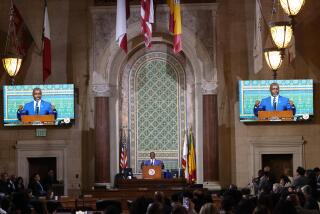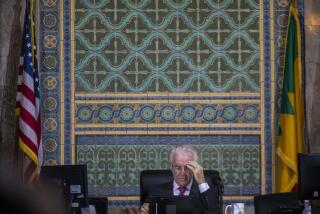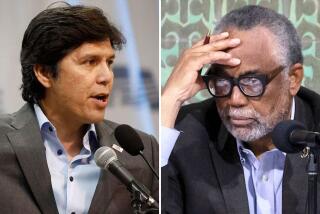Term Limits Closing the Door on an Era at L.A. City Council
Remember the days when lobbyists would roam the corridors of City Hall at Christmastime, handing out bottles of the finest scotch? When cigar smoke would waft defiantly from Council President John Ferraro’s office, despite the smoking ban?
And when lawmakers, untroubled by term limits, could pummel away at a controversial issue -- such as stopping coastal oil drilling -- for years on end until they finally got their way?
These days, the Los Angeles City Council is a much younger, better-behaved and bouncier version of its former self. Term limits, approved by voters in 1993, are ushering the last of the old-timers out the door; 11 of 15 council members have been elected in the last four years, and last week’s elections marked the end of the council tenure of its last three veterans, Ruth Galanter, Nate Holden and Hal Bernson. With them has been swept away decades of institutional knowledge and hard-won coalitions -- and also a lot of colorful history.
Limited to eight years of elected service, today’s officials no longer have the luxury of building long-term alliances or tackling complicated projects that may take years to resolve, such as the dogged pursuit of a ban on coastal oil drilling, or Hal Bernson’s long effort to shore up Los Angeles buildings against earthquakes, or former Councilman Marvin Braude’s step-by-painstaking-step effort to ban smoking in restaurants and offices. The permanent government of lobbyists and bureaucrats has claimed a larger share of influence as elected leaders have pulled back, said Los Angeles County Supervisor Zev Yaroslavsky, who sat for nearly 20 years with the council.
One result has been a drift toward professionalism -- at the expense of idiosyncrasy.
Term limits, however, are not the sole reason for the shifting sands at City Hall. The city Ethics Commission, instituted in the early 1990s, cleaned up some of the old back-scratching with new restrictions on lobbyist gifts and campaign spending. The 1999 overhaul of the City Charter gave more power to the mayor at the expense of the council. In some cases, close campaigns made big differences -- in 2001, for instance, Jack Weiss narrowly beat Tom Hayden, bringing a relative newcomer to the panel and blocking the political aspirations of a passionate veteran of the American left.
Changing social mores, meanwhile, have altered the limits of acceptable behavior. They largely ended an era, for instance, when a councilman could get away with posing for photos with a pretty constituent on his lap.
“Politics has changed,” said political consultant Rick Taylor. Behavior that did little more than raise eyebrows in times past could bring investigations and fines today. This also means that -- even as dress codes have loosened to permit more than gray, black and blue suits -- there is less flamboyance around the ornate council horseshoe.
Take Gil Lindsay, the self-proclaimed “Emperor of the Great 9th,” the district that runs from the skyscrapers of downtown to the hardscrabble streets of South-Central. The former janitor, who became Los Angeles’ first black council member, ruled over the district from 1963 until he died in office in 1990.
An old-style backslapper, Lindsay is remembered for his relentless push to develop downtown. And also for his disdain for election reforms, including laws that required reporting contributions. Once, he threw a fit when police gave him a parking ticket, huffing, “I thought they knew better than to ticket a councilman’s car.” Another time, he bopped a reporter on the head with his cane when the reporter ventured too close to the council horseshoe.
(That horseshoe itself is testament to the council’s changing sensibilities. Today’s members sit facing the audience, which is typical for local government officials in California. For decades, until the new City Hall reopened two years ago, Los Angeles council members sat with their backs to their constituents.)
During the 1970s and early 1980s -- what many see as the glory days of the old guard -- the City Council was peopled by diverse and flamboyant lawmakers. Despite their differences, they worked in concert with then-Mayor Tom Bradley on a broad, pro-growth agenda. They also were fun to watch. Many had worked together so long they often related like squabbling siblings. And without the television cameras that now beam their activities into their constituents’ living rooms, they seemed less afraid of letting it all hang out. At times, the clashes were emotional and freighted.
Ready to Fight
Feisty Councilman Ernani Bernardi, who served from 1961 to 1993 in the 7th District seat now occupied by Council President Alex Padilla, once called Councilman Mark Ridley-Thomas “Curly,” stinging the younger councilman with what Ridley-Thomas took to be a racist remark. “Don’t ever say that again!” he snapped back.
And no old-timer will forget when then-Councilmen David Cunningham and Art Snyder almost came to blows during a debate over a proposal for a minority jobs program. As the exchanges grew ever more heated, a red-faced Snyder left his seat and started across the room toward Cunningham. Cunningham also jumped up, but just as the two would-be pugilists were about to meet in the center, Lindsay stepped between them, cooling things down.
The council also weathered scandals, some involving drugs. Former Councilman Mike Hernandez remained in office even after he was arrested while carrying cocaine. Former Councilman Richard Alatorre was the target of a federal corruption investigation and tested positive for cocaine use, but even as the legal and political whirlwind gathered around him, he finished out his term and predicted that he would have won, had he sought reelection.
(Hernandez was charged with cocaine possession and assigned to a rehabilitation program that allowed him to avoid conviction. Alatorre’s positive test came during a custody battle over his niece. After leaving office, he pleaded guilty to felony tax evasion -- he had failed to report almost $42,000 in payments from people seeking his influence -- and was sentenced to eight months of home detention.)
“They became household names within their districts and built political operations,” said political consultant Allan Hoffenblum. “They became institutions, and almost impossible to get rid of, and they knew it.”
Year after year, they pushed forward on major projects while building coalitions and, back in their districts, presiding over the construction of speed bumps and recreation centers and the endless removal of dumped furniture and garbage.
Snyder, who served the city’s Eastside 14th District from 1967 to 1985, said it takes a special breed of politician to do a good job on and be content with the close-to-the-folks, basic-services nature of a council seat.
“You are fundamentally people’s local plumbers,” he said. “Some people don’t like it, but when you find someone who does, you ought to be able to keep voting for them and let their expertise work for you.”
Sitting above the fray in the council president’s chair for much of the period was the late John Ferraro, who for 35 years held the 4th District seat now occupied by Tom LaBonge, his longtime chief field deputy. Ferraro served two terms as president, one in the late 1970s and another from 1987 until his death in 2001.
“We are all sort of his children here,” a tearful Galanter said in announcing Ferraro’s death from cancer. “It’s really hard to lose your dad.”
Those who served under Ferraro attributed his success in keeping the council in line -- not to mention in holding his own seat -- to his moderate politics, his sense of humor and fairness and his lack of a strong political agenda of his own.
Of course, he could play hardball when necessary. In 1981, then-Councilwoman Pat Russell, a housewife who parlayed her League of Women Voters experience all the way to City Hall and went on to become Mayor Tom Bradley’s staunchest ally on the council, desperately wanted to be council president. But Ferraro did not want to give up the job. Russell secured -- in writing -- eight promised votes. On the morning the vote was scheduled, a radiant Russell took her place at the horseshoe. Her husband and son waited in the audience, flowers in hand. “She looked like a bride,” remembered then-Councilwoman Joy Picus.
But when the roll call began, all seven who were backing Ferraro intoned “Joel Wachs” instead. When the roll, which is called alphabetically, reached Wachs, the ambitious young councilman already had seven votes. Although he had pledged to support Russell, he then voted for himself, double-crossing Russell and denying her the presidency, with Ferraro’s behind-the-scenes help.
A Tight Ship
By all accounts, Ferraro ran a tight ship as council president. He would abruptly cut speakers off if they ran over their allotted three minutes, keeping meetings flowing with a gruff bark: “Move the agenda!”
Francine Oschin, who has been a deputy to Bernson for 14 years, said she was struck by the contrast recently when Councilman Eric Garcetti, as Oschin described it, was “going on and on” during a debate. “He’d gone way past three minutes,” she said. And Padilla, “very apologetically ... told him his time was up. And Eric said, ‘I’m concluding, just give me another minute,’ and then went on for another three or four minutes.
“John never would have allowed it,” she said. “He would have cut it off, and if you didn’t understand, he would call you into his office. He would take you off a committee. He would take you off a coveted commission. John clearly understood that there had to be consequences.”
If the old council at times seemed immovable, this one is packed with plenty of bushy-tailed Energizer Bunnies like LaBonge and Wendy Greuel, who relentlessly prowl their districts for potholes or downed tree branches. And whippersnappers like Padilla, who will celebrate his 30th birthday this month.
But experts caution that it is wrong to think these council rookies are outsiders. Many, including LaBonge, Greuel, Councilman Ed Reyes and Councilwomen Jan Perry and Cindy Miscikowski, worked at City Hall for years before they were elected. Two candidates facing May runoffs -- Greig Smith, who is seeking election to Bernson’s 12th District seat, and Deron Williams, who seeks Nate Holden’s seat in the 10th District -- served the incumbents as deputies for years. Two of the newcomers, Villaraigosa and Cardenas, were termed out of the Legislature. And then there’s former police Chief Bernard Parks, who spent three decades on the police force and knows his way around City Hall.
“All we’re doing is electing everyone’s chief of staff,” said Steve Afriat, a City Hall lobbyist and campaign consultant.
That may be true. But they have their own ideas and agendas. And some, such as LaBonge and Weiss, say the downside of term limits can make achieving those dreams more difficult. Councilwoman Janice Hahn, who does not believe in term limits, said she has heard talk of putting a measure on the ballot next year to lengthen the council term limit from eight years to 12.
Carlos Ferreyra, a San Fernando Valley resident who was a leader in last year’s failed secession attempt, said he doesn’t believe term limits have been successful.
“I see a lot of recycling of old politicians, not new people with new ideology,” he said. “Has anything really changed?”
More to Read
Sign up for Essential California
The most important California stories and recommendations in your inbox every morning.
You may occasionally receive promotional content from the Los Angeles Times.











